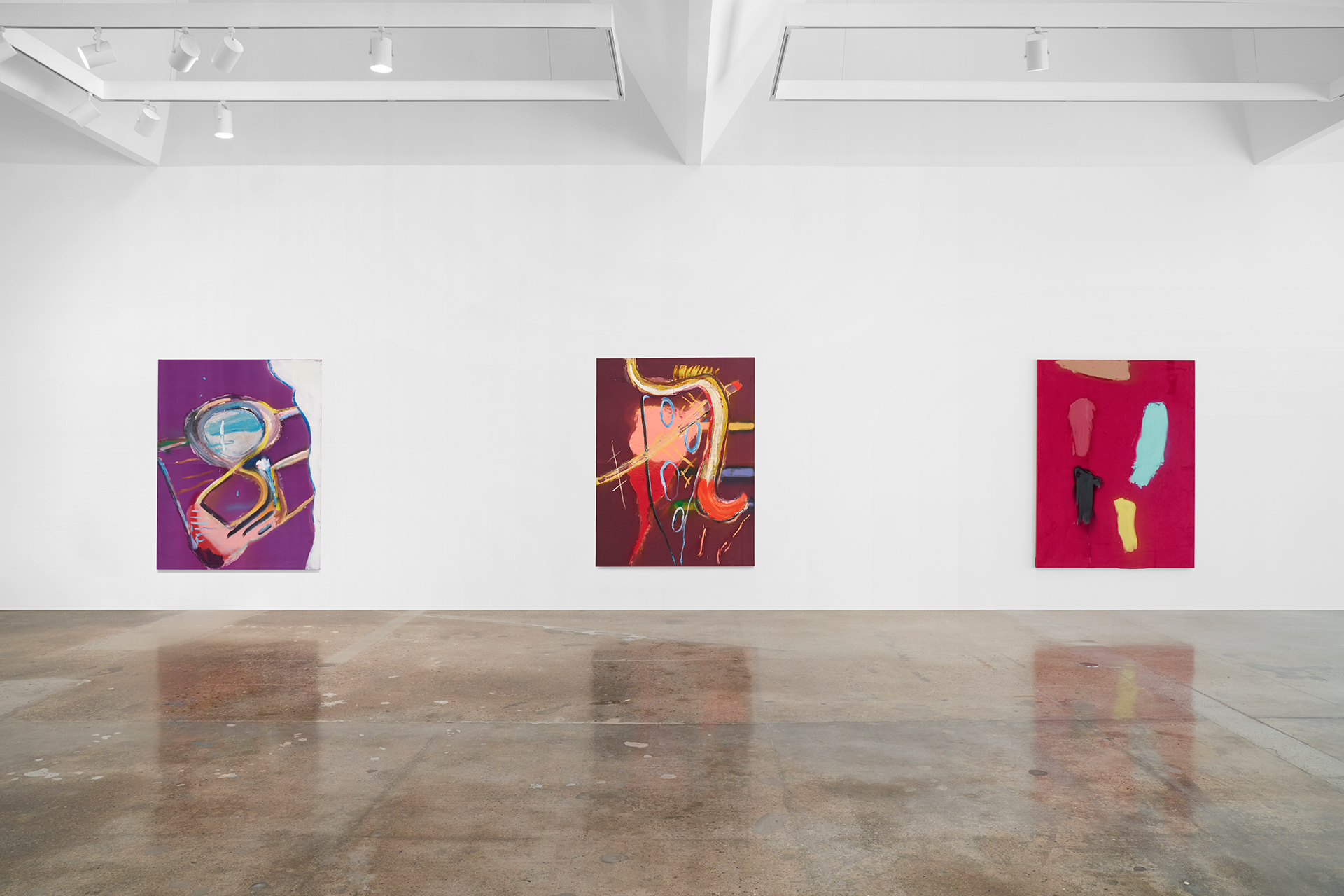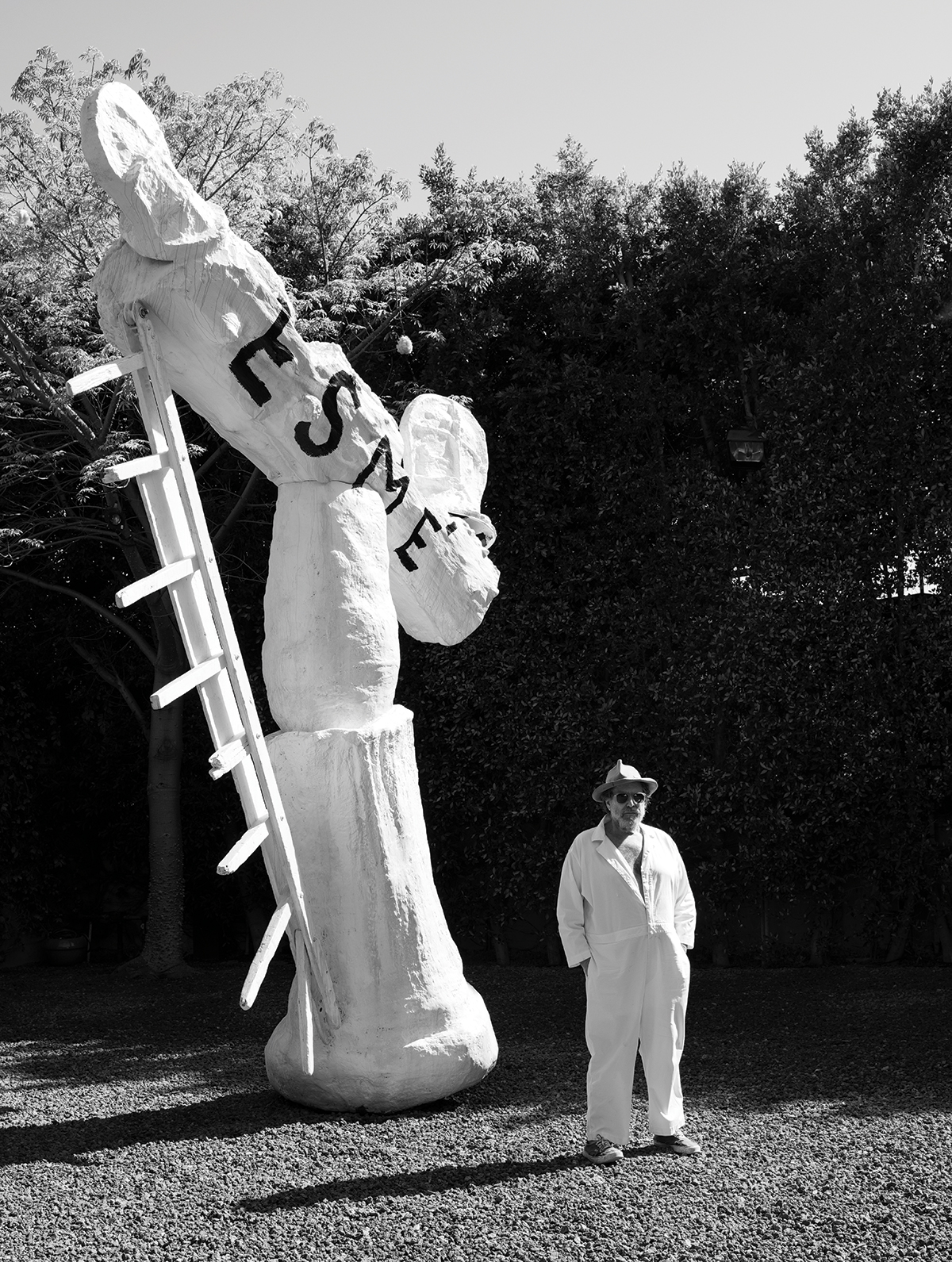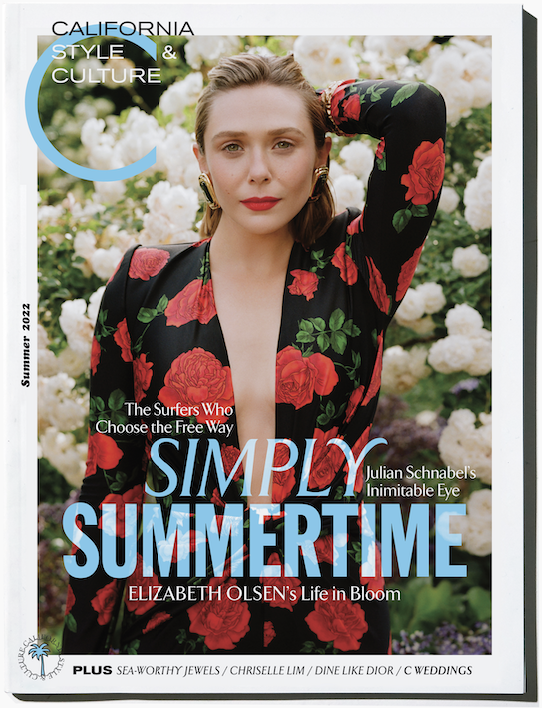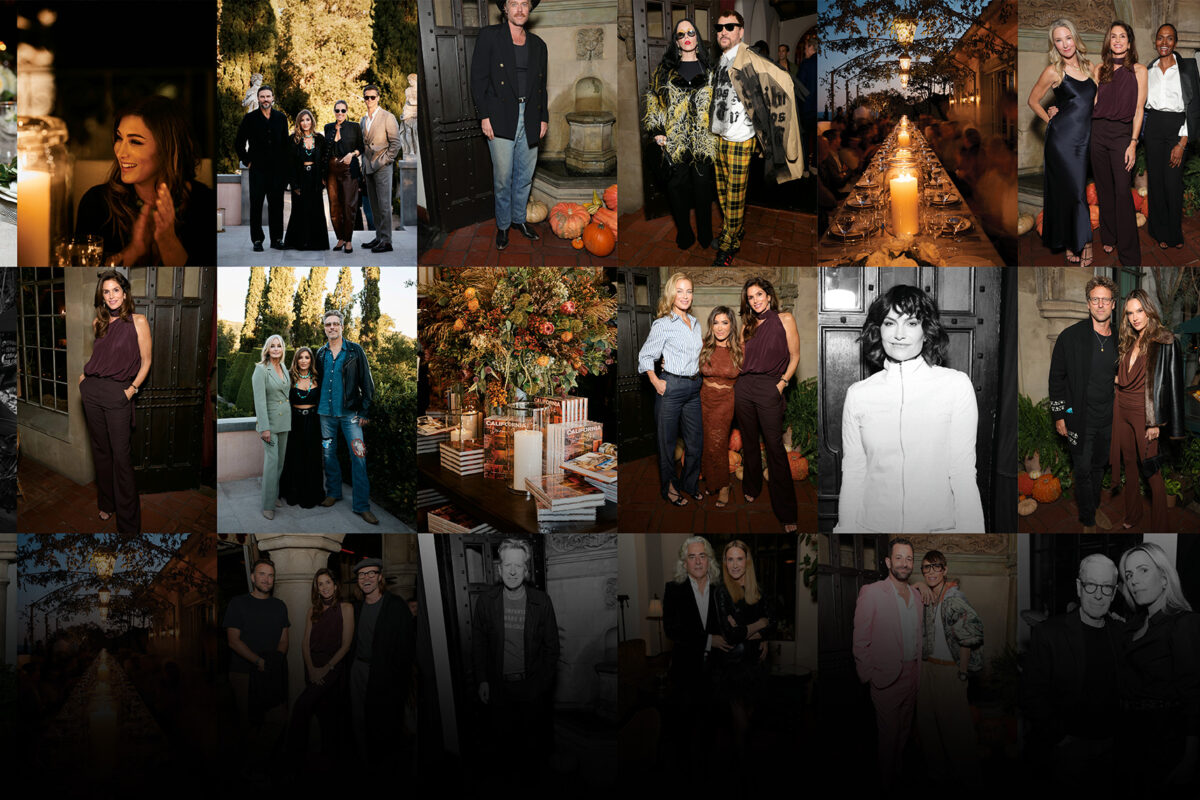With a new L.A. show, a seventh child and a new movie in the works, the prolific polymath shows no signs of slowing down
Words by ALESSANDRA CODINHA
Photography by AMANDA DEMME
It’ s 36 hours before the opening of his new show, “For Esmé — with Love and Squalor,” and Julian Schnabel needs some new rocks. Sheets of gravel line the base of his over 15-foot-tall sculpture, ESMÉ, in the ivy-lined courtyard of Los Angeles’ Pace Gallery. However, something about the gravel’s sun-bleached gray isn’t working with the whitewashed, cast silicon bronze. It isn’t exactly a small patch of gravel, either — roughly enough to cover a basketball court. But you don’t become America’s arguably most famous living painter by loosening your standards. So out went the old rocks and in came the new, noticeably upping the maestro’s mood.
“Well the rocks were gray, and it was kind of abysmal,” Schnabel says when we meet the day before the opening, as hot-pink bougainvillea blows across the newly earth-toned gravel. “Now it looks like we’re in Rajasthan or something like that,” he adds. “You know how they make a red dirt path for you?” Not really, no. “Now it’s more inviting.”
Schnabel, 70, pauses to admire his monumental construction: ESMÉ tilts up toward the sky on an angle, and has something of a flak-gun silhouette; the artist says he was thinking of Francisco Goya’s The Disasters of War — namely the dismembered heads and headless torsos hung on branches. Until recently, he says, this sculpture read INRI, the Latin acronym found on crucifixes meaning “Jesus of Nazareth, King of the Jews,” but then he emblazoned it with the name of his 5-month-old daughter instead.
“I’ve got all sorts of stuff to say about these paintings… Maybe I don’t really want to… People ought to look at things… I don’t want to chew their food for them…”
Julian Schnabel
Three recent works by Schnabel on view at Pace Gallery (from left): Pandora and the Flying Dutchman; Wild Cathedral Evening or Second Painting for Mickey Rourke; and First Painting.
The sculpture is a reconstitution of several prior Schnabel sculptures, some of which were found objects. It’s a method he began 40 years ago when he went to the foundry he uses in New York, saw the leftover molds and thought they looked better than the objects they were used to cast. Some molds previously used for strangers’ heads appear on ESMÉ as bell-shaped protrusions; so does an upturned base of a sculpture named for Schnabel’s eldest son, Vito, a gallerist in his own right with locations in New York and St. Moritz.
Right on cue, Pace President and CEO Marc Glimcher wanders over to say the red rocks were the right decision, before slipping away for a phone call. “I’m kind of a frustrated interior designer,” Schnabel says of the successful swap. It’s another addition to an already extensive resumé.
Julian Schnabel is synonymous with a certain vision of a glamorous, bohemian New York — a place of big personalities and bigger appetites. His huge, million-dollar-plus-selling works made of crushed crockery and painted tarps, and his award-winning films Basquiat, Before Night Falls, and The Diving Bell and the Butterfly, have given him icon status in the art and film milieux. He is deserving of his eccentricities, from the pink West Village palazzo where he meets his famous friends to his decades-preferred uniform of silk pajamas, worn regardless of setting or season. It’s almost disconcerting to see as iconic a New Yorker as Schnabel surveying a show in Los Angeles, like coming across the Chrysler Building in the middle of La Brea. “[Schnabel] changed the idea of what it meant to be an artist,” Glimcher says. “It’s undeniable that there was an art world before Julian Schnabel and an art world after.”
Here we are, in the after. “For Esmé” takes its name from the beloved 1950 J. D. Salinger story, in which a shell-shocked World War II sergeant finds hope in a passing encounter and act of generosity from a precocious kid, the sort of deeply wise preteen girl the author was famously fascinated by. Esmé is also, of course, the name of the newest addition to Schnabel’s prolific brood. Her mother is Louise Kugelberg, a Swedish interior designer who co-wrote and co-edited Schnabel’s 2018 film At Eternity’s Gate, set during the last months of Vincent Van Gogh’s life and starring Willem Dafoe. “She’s not a writer, but who’s stopping her?” Schnabel says, quick to note that she’s no slouch in design either. “When I had the show at the Musée d’Orsay she designed all the walls, and when the show was gone and they put the Van Gogh and Gauguin paintings back, they left the walls the way she designed them.”
“I want to paint what I don’t know”
Julian Schnabel
JULIAN SCHNABEL stands with his over 15-foot sculpture, ESMÉ.
But back to these paintings. An exchange while walking in large slow arcs through the gallery goes something like this:
“Well, I mean I’ve got all sorts of stuff to say about them but maybe I don’t really want to.”
Why not?
“Well, I think people ought to look at things, and I don’t want to chew their food for them. I think you get more out of it if you don’t have the Cliffs Notes.”
But Schnabel can’t help it. He loves art, which, for better or worse, usually means talking about it. He’d certainly prefer to talk about painting than his recent shoulder surgery (the result of “big paintings and surfing”), or his appearances in the hit Netflix series The Andy Warhol Diaries, or specifics on whether he has plans for any more films — he does, things he’s been writing with Kugelberg. “I’ll make more movies. I’ve got about four things I’d like to do before I die,” he says, without further elaboration.
The thing about painting is you don’t have to rely on other people, he says, you don’t have to have all these meetings, you don’t have to ask people for money, or deal with other people’s schedules. The 13 works in “For Esmé” –– many of which take their titles from lyrics in Bob Dylan’s “Chimes of Freedom” — were completed at entirely his own pace over the past two months as news of the war in Ukraine spread across the globe and seeped into his studio. He absorbed the onslaught of news and responded by applying vivid slaps of color and texture on velvet in ways he’d prefer not be described too precisely. He does say, however, that he likes to make paintings that make other painters wonder how he did the things he did, and tells a story about Albrecht Dürer and a paintbrush with only one hair at the end, or maybe two hairs, given the way paintbrushes work.
“I like little people better than grown ups”
Julian Schnabel
Why paint on velvet? “There’s no material that’s really like it. It’s extremely saturated. It’s nice to get a given instead of getting a blank canvas,” he says. “You select a color and it’s already factory made, and it’s kind of perfect. And then you can decide. And in that sense, they’re kind of like monochromatic paintings: The color determines. I’m reacting to the material. I’m reacting to the color.” The first time he made velvet paintings was 40 years ago. “What happens as you make art, you don’t want to repeat yourself but you want to learn from what you did and go somewhere else.” He pauses to admire his handiwork, a thickly painted curve whose layers have been scraped back. “I mean, have you ever seen anything that looks like that?”
He says he recently spent an afternoon teaching the director Paolo Sorrentino (The Great Beauty, Youth, The Hand of God) how to paint. He used the same Velázquez-inspired technique as with Dafoe on the set of At Eternity’s Gate, using a finger and the brow bone and bridge of an interviewer’s nose to demonstrate: “Just paint the light.” The finished painting took around 45 minutes and is quite good, he reports. It now hangs in Sorrentino’s house somewhere, and the Italian director “is over the moon. … He had the most fun he’s ever had with his clothes on.”
Schnabel’s been spending the past few weeks on the road. A strike at the port in Málaga delayed the opening of his show “Schnabel and Spain: Anything Can Be a Model for a Painting” at CAC Málaga. The only works that were there while he was in town were four borrowed from some of his Europe-based collectors, including Miuccia Prada and Albert Oehlen. It could have been worse, he says. “I was very happy to be there with just those four paintings. If you only have four paintings for people to look at, they spend more time looking at those paintings than if there were 25 paintings.” His son, Cy, wrote the show’s catalog and sent him a video of the full opening once it was installed.
“I’ve got about four things to do before I die”
Julian Schnabel
Many of Schnabel’s adult children work in the art world or in close proximity; all of them do if you define movies as art. Was that his preference? “I think whatever they’re doing is fine as long as they’re not in jail and they’re not hurting anybody,” says Schnabel. “One [Olmo, 28] is a really good movie director. His twin brother [Cy, 28] has a gallery and he writes about art, but he’s not a merchant; he’s more of an art historian. Vito [35] is obviously more of a businessman-type person and now he’s acting in his own movie. Lola [41] is a painter. She lives in Sicily. Stella [38] acted in some of my films but I don’t know what she’s doing exactly now. And I have an 8-year-old son named Shooter who lives in New York with us. And we have this little daughter named Esmé.” He pauses. “I like little people better than grown-ups.” Salinger might say that they often are better. “Yes. Then I don’t know what happens.”
For Schnabel, art is “kind of like the anti-gravity machine. I’m 70. And so between surfing and painting it’s sort of a different mindset. Gravity’s gonna get you somehow, but I think I’ve been free of a lot of things. It’s a miracle that I don’t have to cook in a restaurant. It’s a miracle, believe me, every day that I don’t have to work somewhere or do something else. I know the difference.”
The artist stops to consider Pinocchio’s Last Ride, a dark-purple velvet painting interrupted by slashes of light, a small explosion at its center. Has making art changed, five-plus decades since he first erupted on the scene? What inspires him now? “I like the freedom of it. I like the fact that nobody expects it. Nobody wants it. I like to make it,” he says, and recounts the scene in At Eternity’s Gate when Mathieu Amalric’s character asks Van Gogh why he paints. Van Gogh responds that he does it to stop thinking, because when he paints, “I feel that I’m a part of everything outside and inside of me.”
“I once heard that, not from Vincent Van Gogh, but from an aborigine painter,” says Schnabel. “I always thought that was a good explanation for the feeling. But I guess the way I do it is sort of like playing jazz. You’re hitting these notes and you don’t really know, you’re trusting your instinct. … I want to paint what I don’t know, and if in the process I discover something that I think looks like a surprise to me then I’m good with that.” The anti-gravity machine shows no sign of letting him down anytime soon.
Feature image: JULIAN SCHNABEL photographed at PACE GALLERY in Los Angeles.
This story originally appeared in the Summer 2022 issue of C Magazine.
Discover more CULTURE news.







